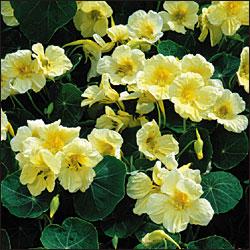Nasturtium Flower
Nasturtium flowers come in an assortment of colors and make excellent additions to any vegetable or flower garden. The best thing about the nasturtium flower is that it is completely edible from the bloom to the leaves and even the seeds. They bloom in vibrant yellow, red and orange hues and can be very decorative and the peppery taste of the plant provides an excellent flavoring for many salads, meats and other dishes.
History
The nasturtium flower is a native of Peru. It was brought from Peru to Spain in the early part of the sixteenth century by Spanish conquistadors. By the end of the sixteenth century, the nasturtium flower had traveled to England and literally dotted the landscape. The flower's name comes from the Latin Nasusm which means nose and Tortus which means twisted. During the 1878 World Exhibition in Paris there were more than 30 different varieties of the nasturtium flower on exhibit. Today, the nasturtium plant can be found in virtually every corner of the world and many use the blooms and leaves for flavoring of various dishes. The seeds are also very commonly found as a substitute for capers.
Facts about Nasturtium Flowers
Like other flowers, the nasturtium flower offers beautiful and vibrant colors and hues. You can find them in various pastel shades ranging from off-white to a pale peach or in more vibrant colors from yellow to the brightest of reds. They are a favorite for many hummingbirds who are attracted to both the beautiful colors and the nectar of the blooms. The buds can be picked late in the spring and then pickled. They should be picked while still green for the best flavor. The flowers as well as the seeds of the nasturtium flower are packed with Vitamin C and iron.
Growing Your Own
You can find many online and offline gardening centers that offer nasturtium seeds for sale. You may even find some that offer the plants for sale as well, although they are very easy to grow and are normally purchased in seed form. They can be grown in early spring just as soon as the last frost has fallen and the soil begins to warm just a bit. For those in warmer climates, seeds can be planted in the fall to late spring. You should plant the seeds no less than ten inches apart and around an inch below the soil's surface. It is best to plant nasturtiums in full sunlight. They do require little care but a weekly watering is often recommended. Be sure that you do not overwater them however or you will receive fewer blooms and more foliage. They typically germinate in around seven to ten days and require no fertilizer or other food for growth. In fact, you really do not have to do much with nasturtium flowers to get them to grow. They thrive very well in semi-neglected situations and can be grown virtually anywhere there is dry soil and plentiful sunlight.
